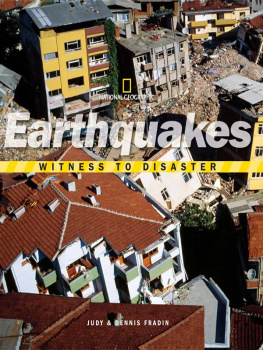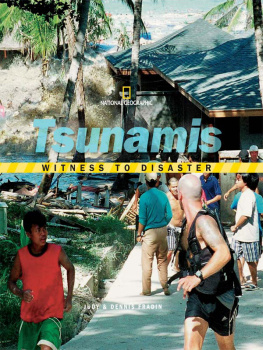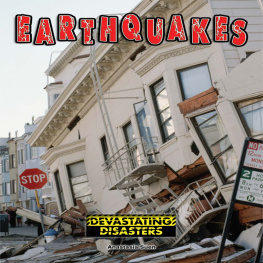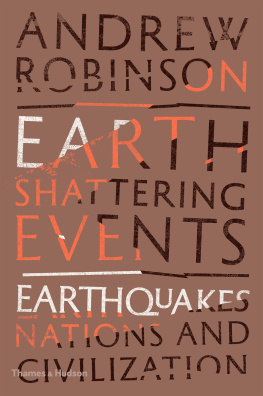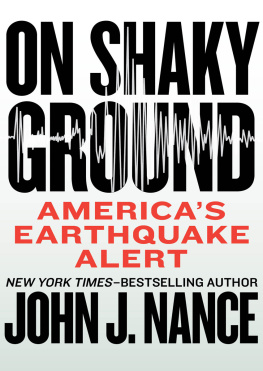Earthquakes
WITNESS TO DISASTER
JUDITH BLOOM FRADIN & DENNIS BRINDELL FRADIN

Text copyright 2008 Judith Bloom Fradin and Dennis Brindell Fradin
Published by the National Geographic Society. All rights reserved. Reproduction of the whole or any part of the contents without written permission from the National Geographic Society is strictly prohibited.

Founded in 1888, the National Geographic Society is one of the largest nonprofit scientific and educational organizations in the world. It reaches more than 285 million people worldwide each month through its official journal, N ATIONAL G EOGRAPHIC , and its four other magazines; the National Geographic Channel; television documentaries; radio programs; films; books; videos and DVDs; maps; and interactive media. National Geographic has funded more than 8,000 scientific research projects and supports an education program combating geographic illiteracy.
For more information, please call 1-800-NGS-LINE (647-5463) or write to the following address: National Geographic Society 1145 17th Street N.W.
Washington, D.C. 20036-4688
U.S.A.
Visit us online at www.nationalgeographic.com/books
For information about special discounts for bulk purchases, please contact National Geographic Books Special Sales at ngspecsales@ngs.org
For rights or permissions inquiries, please contact National Geographic Books Subsidiary Rights: ngbookrights@ngs.org
Fradin, Judith Bloom.
Earthquakes: witness to disaster / by Judy and Dennis Fradin.
p. cm.(Witness to disaster)
Includes bibliographical references.
1. EarthquakesAlaskaAnchorage region. I. Fradin, Judith Bloom. II. Fradin, Dennis B. III. Title.
QE535.2.U6F68 2008
551.22dc22
2007044164
ISBN: 978-1-4263-0979-3
National Geographic Society
John M. Fahey, Jr., President and Chief Executive Officer;
Gilbert M. Grosvenor, Chairman of the Board;
Tim T. Kelly, President, Global Media Group;
Nina D. Hoffman, Executive Vice President; President, Books Publishing Group
Staff for This Book
Nancy Laties Feresten, Vice President, Editor-in-Chief of Childrens Books
Amy Shields, Executive Editor
Bea Jackson, Director of Design and Illustration
Jim Hiscott, Art Director
Lori Epstein, Illustrations Editor
Jean Cantu, Illustrations Specialist
Carl Mehler, Director of Maps
Jennifer A. Thornton, Managing Editor
Priyanka Lamichhane, Assistant Editor
R. Gary Colbert, Production Director
Lewis R. Bassford, Production Manager
Maryclare Tracy, Nicole Elliott, Manufacturing Managers
Photo Credits
cover, Reza / NG Image Collection; back, Emory Kristof / NG Image Collection; spine, Bill Roth/ Anchorage Daily News/ Associated Press; 2-3, James Balog/Getty Images; 5, Koji Sasahara/ Associated Press; 6, Ward W. Wells/ Anchorage Museum at Rasmuson Center; 9, Pratt Museum; 10, Stan Wayman/Life Magazine, Copyright Time Inc./ Time Life Pictures/Getty Images; 11, Central Press/Getty Images; 12, Chiaki Tsukumo/ Associated Press; 13, Museum of Fine Arts, Boston. Reproduced with permission. c2000 Museum of Fine Arts, Boston. All Rights Reserved; 15, NG Image Collection; 16 up left, Susan Sanford/ NG Image Collection; 16 up right, Susan Sanford / NG Image Collection; 16 lo left, Susan Sanford / NG Image Collection; 16 lo right, Susan Sanford / NG Image Collection; 18, Ann Johansson/ Associated Press; 19, Kashuhiro Nogi/ AFP/ Getty Images; 21, J.R. Stacy/ USGS; 22, Library of Congress; 23, National Information Service for Earthquake Engineering, EERC, University of California, Berkeley; 25, USGS; 26, Newspaperarchive.com ; 27, Library of Congress; 28, J. B. Macelwane Archives, Saint Louis University; 29, USGS; 31, T. Kuribayashi, National Information Service for Earthquake Engineering, EERC, University of California, Berkeley; 32, Chris Sattlberger/ Photo Researchers, Inc.; 33, Banaras Khan/ AFP/ Getty Images; 35, Mike Poland/ USGS; 37, Commander Emily B. Christman/ NOAA; 38, Chuck Nacke//Time Life Pictures/Getty Images; 39, C.E. Meyer/ USGS; 40-41, Farzaneh Khademian/Corbis; 42, Jim Holmes/ Axiom/ Getty Images; 43, Reza / NG Image Collection; 44, Keystone/ Getty Images;
Introduction: Japan Earthquake
As one of the worlds most earthquake-prone countries, Japan is well prepared for such disasters. Buildings on the island nation are designed to withstand large earthquakes. Schoolchildren are taught how to protect themselves when they occur. Drills are held regularly to make sure citizens react safely when the ground shakes.
But nothing could prepare the Japanese people for what occurred on March 11, 2011. At 2:46 on that Friday afternoon, giant slabs of the Earths crust nearly 200 miles (320 kilometers) long and 100 miles (160 kilometers) wide fractured and were thrust beneath Japans northeast coast. The result was the fourth biggest earthquake to strike our planet over the past century. It was so powerful that it pushed northeastern Japan 13 feet (4 meters) to the east and dropped the islands coastline two feet. Buildings toppled as if they were childrens toys, and people were buried beneath the rubble.
But the quake wasnt done with Japan. The upheaval lifted the sea floor and sloshed the ocean water, spawning giant waves known as a tsunami. Walls of water moving as fast as a jet plane struck the Japanese coast and pounded it with waves as tall as a three-story building.
The earthquake and the tsunami waves it created killed an estimated 25,000 people. In addition, the disaster damaged a cluster of nuclear reactors, leaving survivors without electricity. Leaking radioactive fumes from the reactors forced tens of thousands of people to evacuate the area. Many fear that radioactive contamination from the reactors may prove harmful to people who lived nearby.
It could take years for Japan to recover from this disaster. As spectacular as it was, the Japanese earthquake was just one of many thousands of large earthquakes that have rocked our planet and that will continue to do so as long as there is an Earth.
CHAPTER 1
The Ground Would Not Stop Shaking
Alaska, 1964
I turned and watched my house squirm and groan, as though in last mortal agony. It was as though someone had engaged it in a gigantic taffy pull, stretching it, shrinking it, and twisting it.
Robert B. Atwood , then editor and publisher of the Anchorage Daily Times

T he afternoon of March 27, 1964, seemed to be shaping up as a pleasant time for thousands of Alaskans. In Anchorage and other cities, people were heading home from work, preparing dinner, or getting ready for Easter weekend. But then something happened to make that Good Friday a day that Alaskans will never forget. At 5:36 p.m., 13 miles below ground in southern Alaska, massive blocks of rock suddenly shifted and snapped, causing a gigantic earthquake.
I was next door at my friend Raymonds house when it started, Michele Doran recalls about that afternoon. Along with nearly 50,000 other people, eight-year-old Michele lived in Anchorage, Alaskas biggest city. We were watching cartoons and dancing. We had experienced lots of small quakes before, so at first we werent scared.

